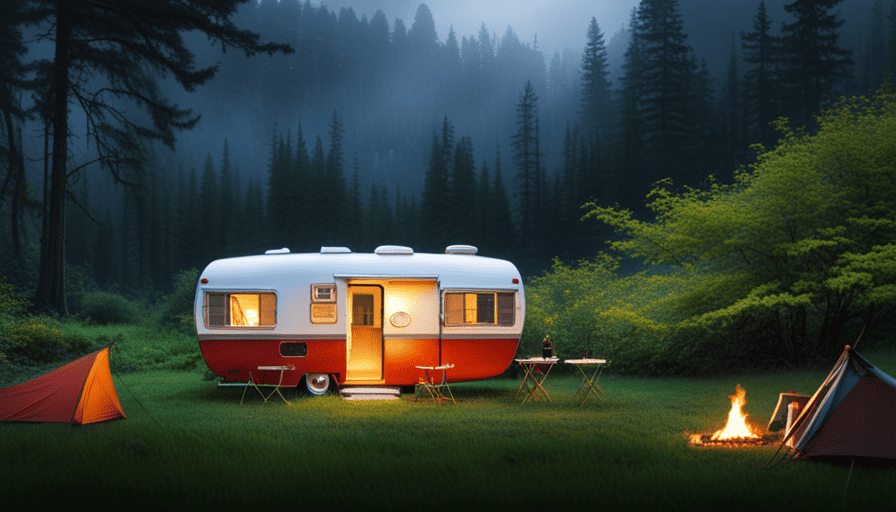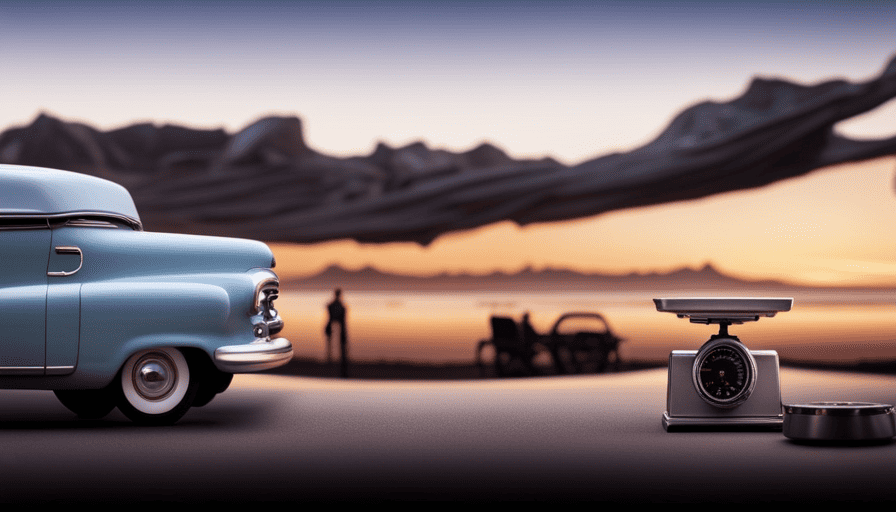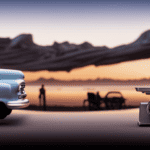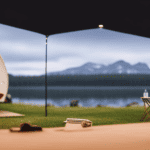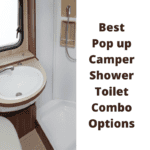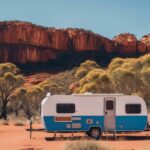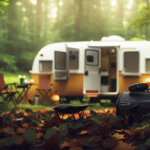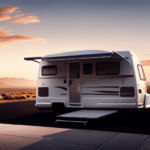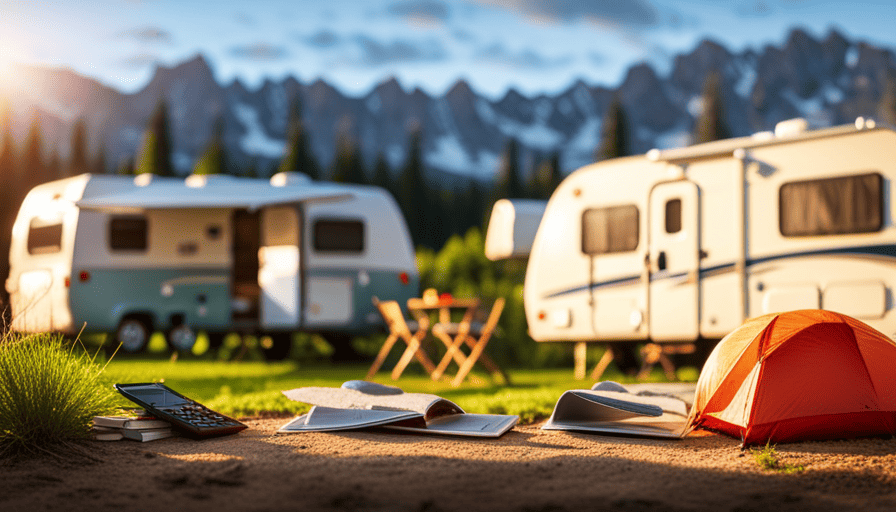Did you know that the average cost of a pop-up camper is approximately $10,000?
That’s right, these portable and versatile campers offer a cost-effective way to enjoy the great outdoors without breaking the bank.
In this article, I will provide you with all the information you need to know about the cost of pop-up campers.
Firstly, I will discuss the different types of pop-up campers available on the market, ranging from basic models to more luxurious options.
Then, I will explore the pros and cons of buying a new versus a used pop-up camper, including their respective price ranges and considerations.
Furthermore, I will delve into the various features and amenities that can influence the cost of a pop-up camper, such as air conditioning, kitchen appliances, and bathroom facilities.
Additionally, I will discuss how the size and sleeping capacity of a camper can affect its price.
Moreover, I will highlight the importance of considering the brand and manufacturer of a pop-up camper, as well as the financing options available.
I will also provide tips on how to research and compare different models, negotiate and bargain for a better price, and budget effectively to make this investment more affordable.
So, if you’re curious about the cost of pop-up campers and want to make an informed decision, keep reading!
Key Takeaways
- The average cost of a pop-up camper is $10,000.
- Buying new offers warranty and customization options, but can be more expensive.
- Buying used can save money, but careful inspection is necessary.
- Additional costs to consider include insurance, maintenance, and upgrades.
Types of Pop-Up Campers
Now let’s explore the various types of pop-up campers and see which one suits your adventurous spirit! When it comes to pop-up campers, there are a few different options to choose from.
One popular type is the folding trailer, also known as a tent trailer. These campers feature a collapsible design that allows for easy towing and storage.
Another type is the A-frame camper, which has a triangular shape when set up and provides a more spacious interior compared to the folding trailer.
Finally, there are the pop-up truck campers, which are designed to fit onto the bed of a pickup truck, providing a convenient and compact camping experience.
When considering the cost of a pop-up camper, you’ll have to decide between new and used options. New campers offer the advantage of being in pristine condition and often come with warranties. However, they can be more expensive. On the other hand, used pop-up campers can be more budget-friendly, but you’ll need to carefully inspect them for any potential issues.
As for the best brands and models, some popular choices include Jayco, Forest River, and Coachmen. These brands are known for their durability, quality construction, and innovative features. Models such as the Jay Series Sport and the Flagstaff MAC series are highly rated by camping enthusiasts.
Now, let’s transition into the subsequent section about new vs. used pop-up campers and explore the pros and cons of each option.
New vs. Used Pop-Up Campers
When it comes to buying a pop-up camper, there are pros and cons to both buying new and buying used. On one hand, buying new allows you to have the latest features and a warranty, giving you peace of mind.
However, buying used can save you money and still provide you with a reliable camper, although you may have to compromise on certain features.
Ultimately, the decision between buying new or used will depend on your budget and preferences.
Pros and Cons of Buying New
Consider the thrill of owning a brand-new pop-up camper, with all its modern conveniences and the satisfaction of being the first to explore the open road in style. Buying new certainly has its advantages. Firstly, you have the peace of mind knowing that everything is in pristine condition and under warranty. Secondly, you can customize the camper to your liking, adding features that suit your needs. However, there are some factors to consider when buying new. The cost is often higher compared to used campers, and the value depreciates quickly. Additionally, you may have limited options when it comes to finding the perfect model or floor plan. Despite these considerations, the benefits of owning a new pop-up camper are undeniable. Now, let’s explore the pros and cons of buying used.
Pros and Cons of Buying Used
One of the best things about purchasing a used camper is the potential for finding a great deal on a well-maintained and fully-equipped model. When buying a used pop-up camper, there are a few tips to keep in mind.
First, make sure to thoroughly inspect the camper for any signs of damage, such as leaks or structural issues. It’s also a good idea to ask for maintenance records to ensure that the camper has been well taken care of. Additionally, check the appliances and electrical systems to ensure they’re in working order. Finally, don’t forget to negotiate the price with the seller to get the best deal possible.
By following these buying tips and using an inspection checklist, you can find a used pop-up camper that meets your needs and budget. Transitioning into the next section about features and amenities, it’s important to consider what you’re looking for in a camper.
Features and Amenities
When considering features and amenities in a pop-up camper, there are two main categories to consider: basic features and amenities, and upgraded features and amenities.
Basic features and amenities typically include a comfortable sleeping area, a small kitchenette, and storage space.
On the other hand, upgraded features and amenities may include a bathroom with a toilet and shower, air conditioning, and a larger dining area.
These features can greatly enhance the comfort and convenience of your camping experience, but they also come at a higher cost.
Basic Features and Amenities
Packed with cozy beds, a compact kitchen, and a charming dinette area, a pop-up camper becomes the perfect little home-away-from-home for adventurous souls. This versatile camper offers a range of basic features and amenities that cater to various camping needs. Here are two sub-lists that highlight the deeper meaning behind these features:
Convenience:
- Easy setup and takedown process, allowing for quick transitions between camping spots.
- Lightweight design, making it effortless to tow and maneuver.
- Foldable walls and roof, providing a compact storage solution when not in use.
Comfort:
- Comfortable sleeping arrangements, with some models offering mattress upgrades for a better night’s sleep.
- Functional kitchenette with a stove, sink, and refrigerator, allowing for convenient meal preparation.
- Cozy dinette area for enjoying meals or playing board games with family and friends.
These basic features and amenities provide a solid foundation for a comfortable camping experience. However, for those seeking upgraded options and customization possibilities, the next section will explore the exciting world of upgraded features and amenities.
Upgraded Features and Amenities
In addition to the basic features and amenities, pop-up campers also offer a range of upgraded features and luxury options. These upgrades are designed to enhance your camping experience and provide you with added comfort and convenience.
Some of the upgrades available include upgraded kitchen appliances, such as a refrigerator or a microwave, as well as a built-in bathroom with a shower and toilet. Other luxury options may include air conditioning, a stereo system, and even a flat-screen TV. These additional features can significantly increase the cost of a pop-up camper, but they can also greatly enhance your overall camping experience.
With these upgrades, you can enjoy the comforts of home while still being able to enjoy the great outdoors.
Now, let’s move on to the next section where we will discuss the size and sleeping capacity of pop-up campers.
Size and Sleeping Capacity
Looking for a pop-up camper that can comfortably accommodate your whole crew? When considering the size and sleeping capacity of a pop-up camper, it’s important to look at the pop-up camper weight and the pop-up camper set up time.
The weight of a pop-up camper can vary depending on its size and construction materials. Lightweight pop-up campers can weigh as little as 600 pounds, while larger models can weigh up to 3,000 pounds or more.
As for set up time, pop-up campers are known for their quick and easy setup. With some practice, you can have your pop-up camper fully set up and ready to go in just a matter of minutes. This makes them a popular choice for those who want a hassle-free camping experience.
Now, let’s move on to the next section where we will discuss the importance of brand and manufacturer when choosing a pop-up camper.
Brand and Manufacturer
Don’t underestimate the importance of brand and manufacturer when it comes to choosing a pop-up camper, because who needs reliability and quality when you can have constant breakdowns and disappointment? When it comes to pop-up campers, brand reputation and customer reviews play a significant role in determining the overall value and satisfaction you’ll get from your purchase.
Choosing a well-known and reputable brand ensures that you’re investing in a camper that’s been tested and proven by other customers. Brands that’ve been in the industry for a long time often have a solid reputation for producing high-quality campers that’re built to last. Additionally, these brands typically have a wide network of dealerships and service centers, making it easier to find assistance if any issues arise.
Customer reviews are a valuable resource when researching different brands and manufacturers. They provide insights into the experiences of other campers, giving you a better idea of the camper’s performance, durability, and overall customer satisfaction. By reading reviews, you can learn about common problems or concerns that may arise with certain brands, allowing you to make an informed decision.
Considering brand reputation and customer reviews is essential when purchasing a pop-up camper. It ensures that you’re investing in a reliable and high-quality product that’ll provide years of enjoyment.
Speaking of investments, let’s delve into the topic of additional costs to consider when buying a pop-up camper.
Additional Costs to Consider
When it comes to purchasing a pop-up camper, you’ll want to keep in mind the various additional expenses that may arise. Beyond the initial cost of the camper itself, there are other factors that can affect your overall budget. One important consideration is the cost of insurance. Just like any other vehicle, you’ll need to insure your pop-up camper to protect yourself and your investment. The cost of insurance can vary depending on factors such as the value of the camper, your location, and your personal driving history. Additionally, you’ll need to factor in maintenance costs. Pop-up campers require regular maintenance to keep them in good condition. This can include things like annual inspections, repairs, and routine upkeep. It’s important to budget for these expenses to ensure that your camper stays in top shape for years to come.
To give you a better idea of the potential additional costs, here is a breakdown in a table format:
| Additional Expenses | Estimated Cost |
|---|---|
| Insurance | $500-$1000/year |
| Maintenance | $200-$500/year |
These estimated costs will vary depending on various factors, but they can serve as a starting point for your budget planning.
Considering these additional expenses, it’s important to factor them into your overall budget when purchasing a pop-up camper. Now, let’s move on to discussing financing options for your camper without skipping a beat.
Financing Options
When it comes to financing options for purchasing a pop-up camper, there are two main routes to consider: buying with cash or financing through loans.
Buying with cash allows for immediate ownership without the burden of monthly payments, but it requires a significant upfront investment.
On the other hand, financing through loans provides the flexibility of spreading out the cost over time, but it comes with interest charges and potential credit requirements.
Deciding between these options will ultimately depend on personal financial circumstances and preferences.
Buying with Cash
If you’re ready to hit the road and experience the freedom of the great outdoors, you’ll be pleasantly surprised at how affordable a pop-up camper can be when paying in cash. By buying with cash, you can avoid the hassle of financing options and affordability constraints. Purchasing a pop-up camper outright allows you the freedom to negotiate a better price and eliminates the need to pay interest on a loan. Plus, you won’t have to worry about monthly payments or being tied down to a long-term financial commitment. To give you an idea of the cost range, here’s a table showcasing three different options for pop-up campers:
| Pop-Up Camper Model | Price Range |
|---|---|
| Basic Model | $5,000 – $8,000 |
| Mid-Range Model | $8,000 – $12,000 |
| High-End Model | $12,000 – $18,000 |
Buying a pop-up camper with cash provides you with financial flexibility and the ability to start your outdoor adventures right away. Now, let’s explore the next section about financing through loans.
Financing through Loans
Now, let’s explore the option of financing through loans when it comes to purchasing a pop-up camper. This can be a viable alternative for those who don’t have the cash upfront or prefer to spread out the cost over time.
Financing options for pop-up campers vary depending on the lender, but it’s important to consider your credit requirements. A good credit score will generally result in better interest rates and loan terms. It’s advisable to shop around and compare different lenders to find the best deal that suits your financial situation.
Keep in mind that interest rates and loan terms can greatly impact the overall cost of the camper in the long run. With this in mind, let’s move on to the next section where we will discuss the importance of research and comparison.
Research and Comparison
When it comes to researching and comparing pop-up campers, I always start by reading reviews and ratings from other customers. This allows me to get a sense of the overall quality and reliability of the camper, as well as any potential issues or concerns.
Additionally, comparing prices and features is essential to finding the best value for my money. By carefully comparing different models, I can ensure that I’m getting the most bang for my buck and selecting a pop-up camper that meets all of my needs and preferences.
Reading Reviews and Ratings
While perusing online reviews and ratings, it’s clear that pop-up campers come in a wide range of prices.
Reading reviews is an essential step in the buying process as it allows you to gather insights from real customers who have already experienced the product. These reviews provide valuable information about the quality, durability, and features of different pop-up campers.
Additionally, reviewers often mention the price they paid for their camper, giving you a rough idea of what to expect in terms of cost. However, it’s important to note that prices can vary depending on factors such as brand, size, and additional features.
By carefully reading reviews and comparing prices, you can make an informed decision when it comes to selecting the pop-up camper that best fits your needs and budget.
In the next section, we will delve into the process of comparing prices and features to find the perfect pop-up camper for you.
Comparing Prices and Features
Comparing prices and features allows you to make an informed decision and find the perfect pop-up camper that meets both your needs and budget. To help you in your search, here are four key factors to consider:
-
Price range: Determine your budget and compare prices across different brands and models. Keep in mind that higher prices may indicate better quality and more features.
-
Features: Look for features that are important to you, such as sleeping capacity, storage space, kitchen facilities, and bathroom amenities. Consider whether you need additional accessories like awnings or bike racks.
-
Pop-up camper maintenance: Research the maintenance requirements of different models. Some may require more upkeep than others, so factor in the time and cost involved in maintaining your camper.
-
Pop-up camper accessories: Consider the accessories that come with the camper or are available as add-ons. These could include things like portable grills, camping chairs, or outdoor rugs.
By comparing prices and features, you can find the best pop-up camper for your needs. Transitioning into the next section about negotiating and bargaining, it’s important to be aware of the potential for price adjustments and deals.
Negotiating and Bargaining
If you’re looking to save some money, you can definitely try negotiating and bargaining for a better price on a pop-up camper. When it comes to negotiating tips, it’s important to do your research beforehand.
Find out the average price range for the type of pop-up camper you’re interested in, so you have a baseline to start from. It’s also helpful to know the market conditions and any sales or promotions that may be happening.
When it comes to bargaining strategies, one approach is to start with a lower offer than what you’re willing to pay. This gives you room to negotiate and potentially get a better deal. Another strategy is to bundle additional items or accessories into the deal. For example, you could ask for a discounted price if you also purchase camping gear or maintenance supplies.
Additionally, it’s important to be polite and respectful throughout the negotiation process. Remember that the seller is also looking to make a profit, so finding a win-win solution is ideal. Be prepared to walk away if the price doesn’t meet your budget, but also be open to compromise if the seller is willing to meet you halfway.
Negotiating and bargaining can be effective ways to save money on a pop-up camper. By using these strategies and being well-informed, you can increase your chances of getting a better deal.
Now let’s dive into the next section about budgeting and affordability.
Budgeting and Affordability
Now let’s explore how to budget for and determine the affordability of a pop-up camper. Budgeting for a pop-up camper involves considering the upfront cost of the camper itself, as well as ongoing expenses such as insurance, maintenance, and camping fees.
The price range for pop-up campers can vary greatly depending on factors such as brand, size, features, and condition. On the lower end, you can find used pop-up campers for around $2,000 to $5,000. These may be older models or ones that require some repairs or renovations.
In the mid-range, you can expect to pay between $5,000 and $10,000 for a newer, well-maintained pop-up camper with more features and amenities. For those looking for top-of-the-line models with all the bells and whistles, prices can exceed $10,000.
It’s important to consider your budget and prioritize your needs when determining the affordability of a pop-up camper. Remember to factor in additional costs such as insurance, maintenance, and any upgrades or accessories you may want to add. By carefully budgeting and considering the price range, you can find a pop-up camper that suits your needs and fits within your financial means.
Frequently Asked Questions
Are there any additional costs to consider when purchasing a pop-up camper besides the initial price?
When purchasing a pop-up camper, there are additional costs to consider besides the initial price. These include maintenance expenses, which can vary depending on the age and condition of the camper. Regular maintenance tasks may include cleaning, inspections, repairs, and replacing worn-out parts.
Additionally, you may need to budget for insurance, storage fees, and licensing fees. It’s important to factor in these additional costs to ensure you have a comprehensive understanding of the overall expenses involved in owning a pop-up camper.
What are some financing options available for buying a pop-up camper?
When it comes to financing options for buying a pop-up camper, there are a few choices available.
One option is to obtain a loan from a bank or credit union. This allows you to spread out the cost over time, making it more affordable.
Another option is to finance through the dealership where you purchase the camper. While this may be convenient, it’s important to compare interest rates and terms.
It’s important to weigh the pros and cons of financing a pop-up camper, such as the potential interest costs and the impact on your credit score.
How can I research and compare different pop-up camper models to find the best fit for my needs?
When researching and comparing different pop-up camper models, it’s important to consider various factors to find the best fit for your needs.
Start by exploring online resources such as manufacturer websites, forums, and review websites. Look for key features like size, weight, sleeping capacity, storage options, and amenities.
Additionally, consider factors such as durability, ease of setup, and customer reviews.
By thoroughly researching and comparing these factors, you can make an informed decision on the perfect pop-up camper for your adventures.
Do I have any negotiating power when buying a pop-up camper, and what are some bargaining tips to help get a better deal?
When it comes to negotiating a deal on a pop-up camper, there are several strategies you can employ to increase your chances of getting the best price.
First, do your research and compare prices from different sellers. This will give you a better understanding of the market value and help you identify any overpriced listings.
Additionally, be prepared to negotiate and don’t be afraid to walk away if the price doesn’t meet your expectations.
Lastly, consider timing your purchase during the off-season when sellers may be more willing to negotiate for a better deal.
How can I budget and determine if I can afford a pop-up camper before making a purchase?
When budgeting for a pop-up camper and determining if you can afford it, it’s essential to consider various factors. Start by assessing your financial situation and setting a realistic budget.
Consider the upfront costs, such as the purchase price, insurance, and registration fees. Additionally, factor in ongoing expenses like maintenance, repairs, and storage fees.
It’s crucial to weigh these costs against your income and other financial obligations to ensure that you can comfortably afford a pop-up camper without straining your finances.
How Does the Cost of Winterizing a Camper Compare to the Cost of Purchasing a Pop-Up Camper?
The cost of winterizing a camper varies depending on factors such as the type of camper and the services required. It typically ranges from $100 to $300, which includes draining water tanks, adding antifreeze, and insulating the camper. In comparison, the cost of purchasing a pop-up camper can range from $5,000 to $20,000 or more, depending on the brand, features, and condition.
Conclusion
After considering all the factors mentioned above, it’s clear that the cost of a pop-up camper can vary greatly depending on various factors.
Just like a traveler embarking on a scenic journey, one must carefully navigate through the options, considering the type, condition, features, and brand of the camper.
By diligently researching, comparing, and negotiating, one can find a camper that fits their budget and provides the ideal camping experience.
So, as you embark on your own camper search, remember to stay patient, persistent, and open-minded, and soon enough, you’ll find the perfect pop-up camper to accompany you on your outdoor adventures.

